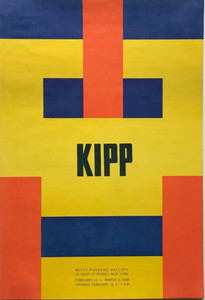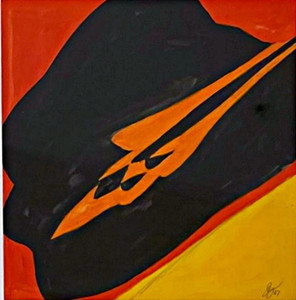
Jack Youngerman, October 1, from Betty Parsons Gallery, 1964
Jack YoungermanCONTACT GALLERY FOR PRICE
Jack Youngerman
October 1, from Betty Parsons Gallery, 1964
India ink on paper, with original Betty Parsons Gallery label
Pencil signed and dated '64 on the front; also signed, titled and dated on the back. (shown); bears original Betty Parsons label affixed
Unique
Frame included
Rare mid 1960s work on paper by the renowned American abstract artist Jack Youngerman. Excellent provenance from the renowned Betty Parsons Gallery. The work has been elegantly framed in a museum quality wood frame under UV plexiglass, but the original label from the Betty Parsons Gallery has been removed from the 1960s Kulicke frame and affixed to the back of the new frame. There is also a die-cut window in the back to reveal the artist’s second signature and title.
Measurements:
Framed
27 inches (vertical) by 33 inches (horizontal) by 1.5 inches
Artwork:
24 inch vertical by 29
Jack Youngerman Biography
Jack Youngerman was born in 1926 in Webster Groves, Missouri, moving to Louisville, Kentucky in 1929 with his family. He studied art at the University of North Carolina from 1944 to 1946 under a wartime navy training program, and graduated from the University of Missouri in 1947. In the fall of 1947, Youngerman moved to Paris on a G.I. Scholarship; he enrolled at the Ecole des Beaux-Arts where he studied with Jean Souverbie. He traveled to the Netherlands, Belgium, Spain, Italy and Greece, to visit art museums and historic sites. In 1948, he formed a lifelong friendship with Ellsworth Kelly and also met Eduardo Paolozzi and César, each fellow students at Ecole des Beaux-Arts.
Career
In 1950, Youngerman had his first group exhibition, Les Mains eblouies at Galerie Maeght in Paris, which also included Pierre Alechinsky, Eduardo Chillida and Corneille. He visited the studios of Constantin Brancusi and Jean Arp with Kelly, and found himself influenced by their sense of organic form. He met Alexander Calder through his father-in-law, Henri Seyrig, a renowned archaeologist and cultural attache to the Free French delegation to the United States. During this time he became interested in the resurgence of geometric abstraction in Paris, especially in exhibitions such as Salon des Réalités Nouvelles which included Max Bill, Auguste Herbin and Richard Lohse. Youngerman also visited the Salon de Mai to see the most current work of the School of Paris artists, among them such masters as Henri Matisse. Youngerman's exposure to the contemporary art in post-war France was critical to his development; he introduced aspects of geometric abstraction and Constructivism into his painting.
In 1951 he mounted his first one-person exhibition at Galerie Arnaud in Paris. During this time he met the French artist, Francois Morellet, with whom he developed a life-long friendship. A few years later he travelled to visit Henri Seyrig in Beirut, then Director of Institut Francais d'Archeologie. In 1954 Youngerman was commissioned by the architect Michel Ecochard to create a color design for the College Protestant Français in Beirut.
In 1956 he designed sets for the French actor and director, Jean-Louis Barrault's production of Georges Schehaed's Histoire de Vasco. The American art dealer Betty Parsons visited Youngerman's Paris studio that summer, where she encouraged him to move to New York City.
In December 1956, he returned to the U.S. with his wife, Delphine Seyrig, and son; they rented a space in lower Manhattan's Coenties Slip, an area of largely abandoned loft buildings that would become a legendary artists' colony. There his friends and neighbors included Robert Indiana, Jasper Johns, Ellsworth Kelly, Agnes Martin, and Robert Rauschenberg.
Youngerman's first one-person show at Betty Parsons Gallery marked his 1958 New York City debut. His development was unique among his peers, with elemental forms and fluid contours that marked his canvasses through the 1950s with imagery often emanating from a central core. Early in his growth the forms were organic; sometimes botanical in nature. He worked in thick black pigment as if it resided within the color spectrum.
His career continued its ascent with exhibitions at the Carnegie Institute in Pittsburgh and the Corcoran Gallery of Art in Washington, DC. In 1959, Youngerman was featured alongside Johns, Frank Stella, and Kelly in Sixteen Americans, a landmark exhibition curated by Dorothy Miller at the Museum of Modern Art.[5] Between 1961 and 1968, Youngerman exhibited at the Solomon R. Guggenheim Museum, Galerie Lawrence in Paris, Galleria dell'Arte in Milan, Everett Ellin Gallery in Los Angeles, the Worcester Art Museum in Massachusetts, and The Phillips Collection in Washington, DC. In 1968, he established a studio in Bridgehampton, New York, settling there full-time in 1995. In 1976, Youngerman received a Guggenheim Fellowship for Fine Arts.
In 2019, Youngerman premiered a body of work titled "Cut-Ups" at Washburn Gallery in New York City. His final exhibition, Jack Youngerman, "Works on Paper," 1954 - 2019, took place at The Drawing Room in East Hampton, NY.











